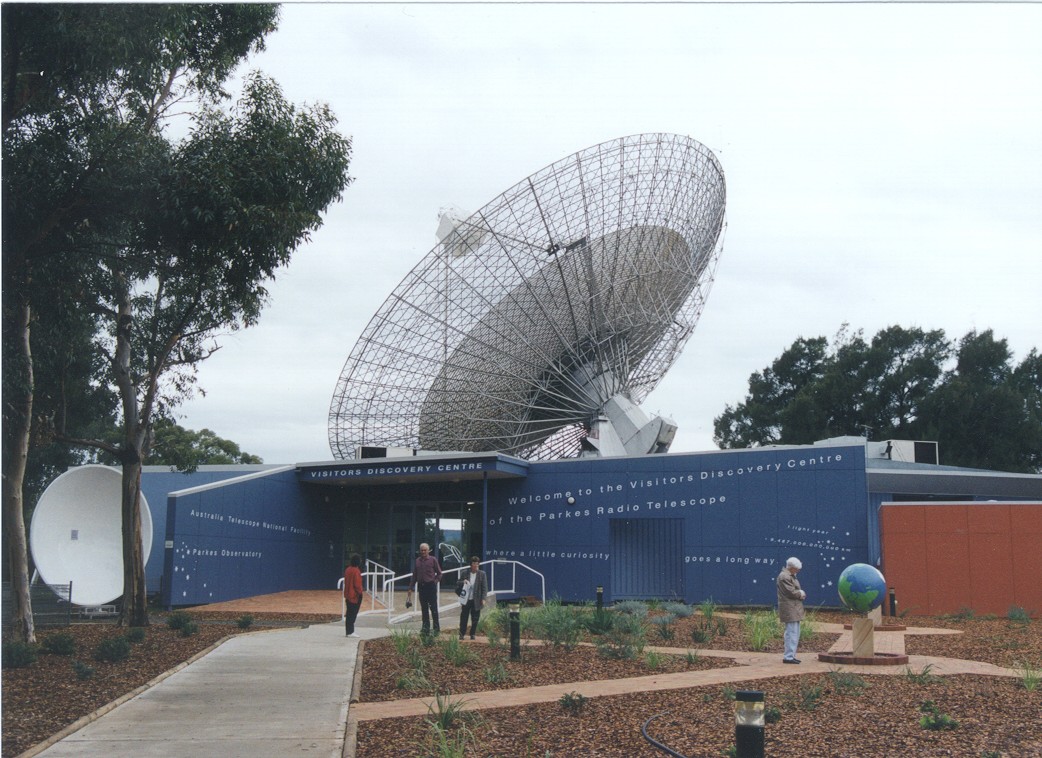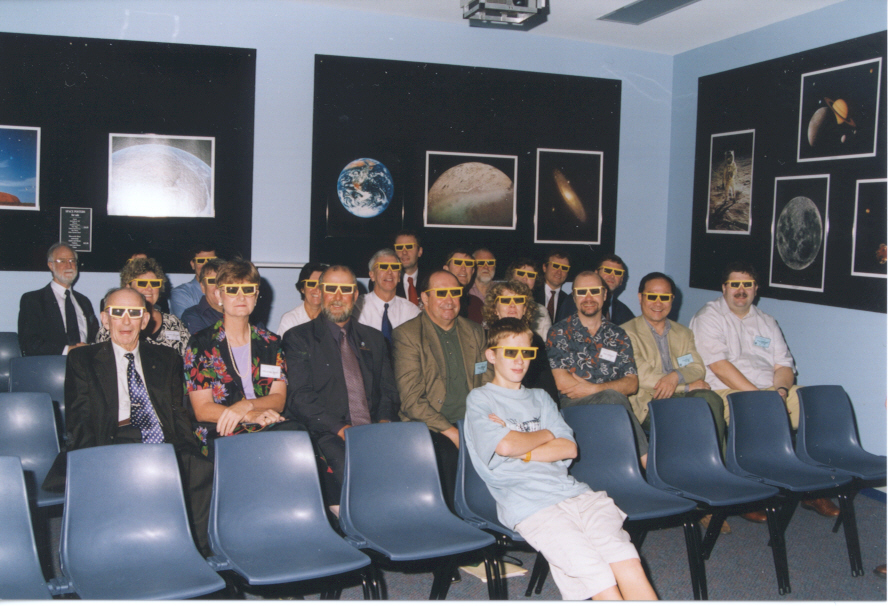New Visitors Centre for the Parkes Observatory
The long-awaited official opening of the upgraded Parkes Visitors Centre and grounds took place on 24 March 2001, attended by a striking assortment of local and visiting dignitaries, and with CSIRO's new Chief Executive Dr Geoff Garrett performing the honours.
The new Centre has double the floor-space of the old, with greatly inceased space for exhibits, shop and audio-visuals (and for staff!). The entrance to the Centre complements newly landscaped grounds to present a welcoming and attractive face to visitors. The building design features a dedicated audio-visual theatre / lecture room specifically designed to encourage visits from school groups, especially from the neighbouring regions. Many new and upgraded displays have already been introduced, mainly through the efforts of Helen Sim and Lucia Bromley-Gambaro. Fabulous video footage of the construction of the telescope and of the Apollo 11 mission, extracted from deep within the archives, is a great new feature. Improving and adding to the exhibits is the focus for activity in the short-term future, with emphasis on more interactive displays a priority.

The Visitors Centre at the Parkes Observatory
The Centre now boasts two new audio-visual shows. The first was produced for the ATNF by the Australian Business Theatre, using the same multiple slide projector format as the original, and was premiered in August 2000. This show retains the extremely high quality visual material and the illusion of animation exploited so successfully in the original, but has been completely re-shot and rewritten to bring it up to date. Response to this show has been excellent, both in feedback and in increased attendance. After the formal opening ceremony in March 2001, the Visitors Centre premiered a new three-dimension virtual reality tour of the Solar System entitled "The Sun _ What a Star". This show, produced by the Swinburne University of Technology's Astrophysics & Supercomputing group, complements the more traditional program of the slide show very nicely, and is also proving to be a crowd-pleaser. Special thanks go to Matthew Bailes of Swinburne for assisting the Observatory in making this show available. Thanks also to Raymond Haynes for assistance with the new slide show.
With greatly increased visitor numbers in recent times, it is now quite common to see visitors arriving after the usual closing time. Latecomers are able not only to view the telescope itself, now an icon of Australian science, but to roam the grounds and inspect a number of new and novel outdoor exhibits. A ¾-metre Earth globe, oriented to show Australia at the top of the world, when in direct sunlight duplicates the daylight regions on the Earth's surface at that moment _ a very simple yet illuminating demonstration. Nearby is a precision sundial which tells the correct standard time all year with an accuracy that surprises many. Both exhibits were designed by Rick Twardy, Manager of the Visitors Discovery Centre. Two huge "whispering dishes" (3.5-m diameter) have been retrieved from obscurity at Marsfield and are now deployed with striking effect in the grounds, proving very popular (and independent of direct solar illumination!). With the dishes almost 50 metres apart, whispered communication provides a vivid and tangible demonstration of the basic concepts embodied so successfully in the parabolic shape of the Parkes dish itself.

Guests at the opening of the new Parkes Visitors Centre watching the 3D virtual reality tour of the Solar System.
The new Centre was officially opened by the Chief Executive of CSIRO, Dr Geoff Garrett, on 24 March 2001. In a novel opening ceremony, a small radio dish detected the microwave energy generated from congratulatory handshakes between Dr Geoff Garrett, Prof Ron Ekers (Director of the ATNF), Mr Robert Wilson (Mayor of Parkes), and Mr Roy Billing (well known for his role of the Mayor of Parkes in "The Dish"), causing a flag to be raised, officially opening the facility. This demonstration elegantly captured the energy, teamwork, and focus required to bring the new Vistors Discovery Centre to fruition. Also present at the ceremony were Tony Blane MLA, member for Dubbo, Jack Scoble, former Mayor of Parkes) and Dr Russell Cannon, Chair of the ATNF Steering Committee.
Other VIP guests included members of the ATNF Steering Committee, Geoff Garrett's family, Lyndsay James of CSIRO Corporate Property, Jim Caddaye of Collins Caddaye Architects and the builder Tim McCabe. The threatening rain fortunately held off long enough for guests to escape into the Centre for a cup of tea and to inspect the interior. Many pictures from the opening are available from the Parkes website: www.parkes.atnf.csiro.au.
The original Visitors Centre at the Observatory was opened in February 1969. The facility was significantly upgraded in 1982 under the operation of CSIRO's Science Communication Unit but was subsequently transferred to the Division of Radiophysics (which then operated the Observatory) around 1985. During the 1980s, several events such as Halley's Comet, supernova 1987A, and Voyager 2 at Neptune captured public interest in astronomy. In 1994, Marcus Price, newly appointed as the Parkes Officer-in-Charge proposed a significant upgrade of the Visitors Centre, aimed at doubling its existing size. The project was finally completed in August 2000, and was funded jointly by the CSIRO corporate capital works programme and by ATNF. Assistance for the landscaping of the grounds was provided by Parkes Council and Tony Lawler, MHR through a Commonwealth Government employment programme.
The opening of the Discovery Centre is well timed: with the recent exposure from the film "The Dish" and related publicity, our visitor numbers for the last eight months have more than doubled. We expect around 110,000 visitors for the calendar year 2001.
It is a pleasure to work in the refreshed and re-invigorated Visitors Discovery Centre, and to count the approving faces of visitors. We aim to present the wonder of astronomy to anyone who is interested and to highlight the important contributions to radio astronomy that the CSIRO has made through the ATNF and its predecessor the Division of Radiophysics. Our vision is that the new Visitors Discovery Centre will stand as an attraction in its own right, a destination which will attract visitors from near and far. The new Visitors Centre is a credit to those involved in the project and speaks loudly and clearly of CSIRO's commitment to inform and educate the public of our achievements in the field of radio astronomy.
"A little curiosity goes a long way ... and leads to great things!"
Rick Twardy
Manager, Parkes Visitors Discovery Centre
(Rick.Twardy@atnf.csiro.au)
